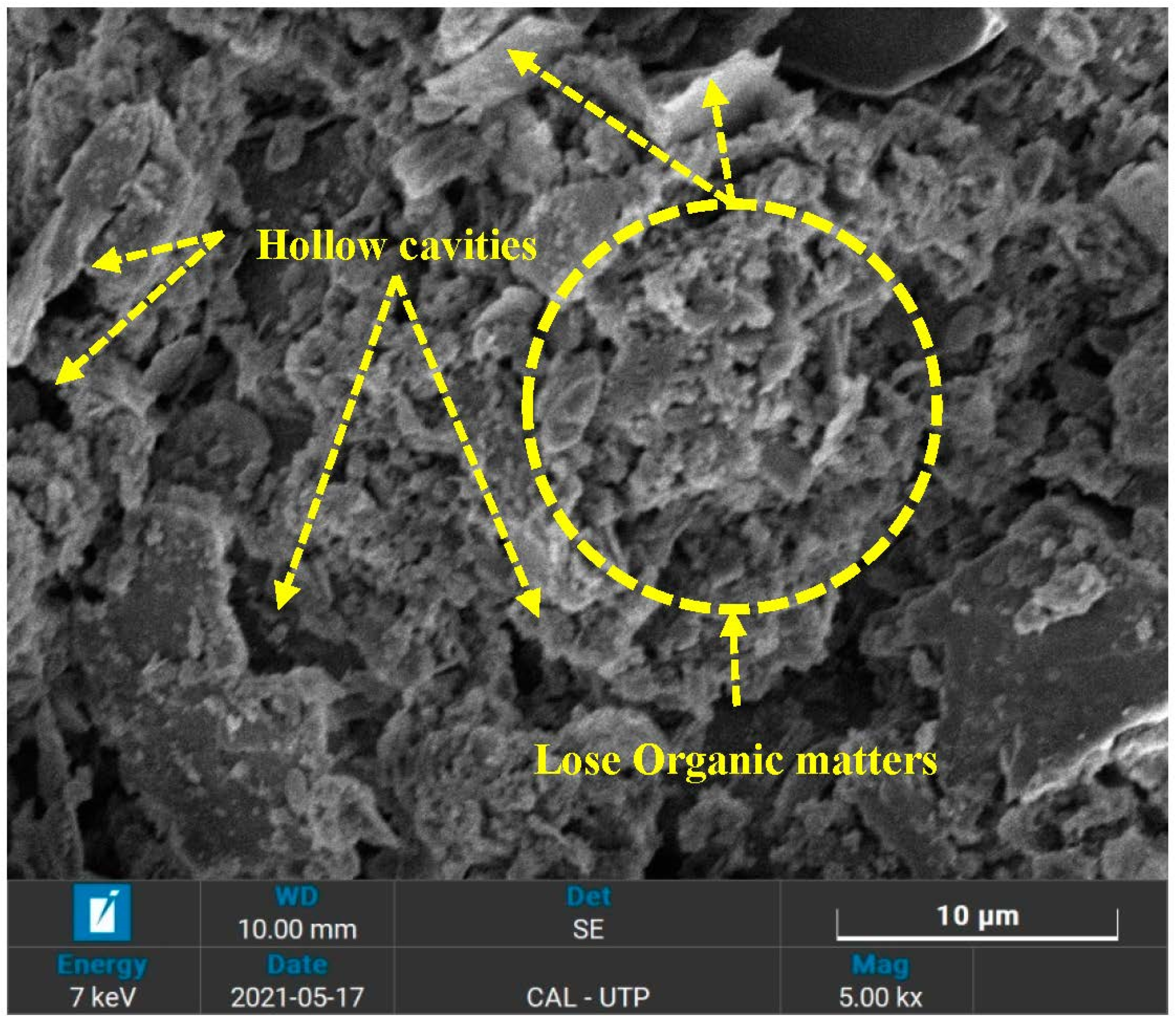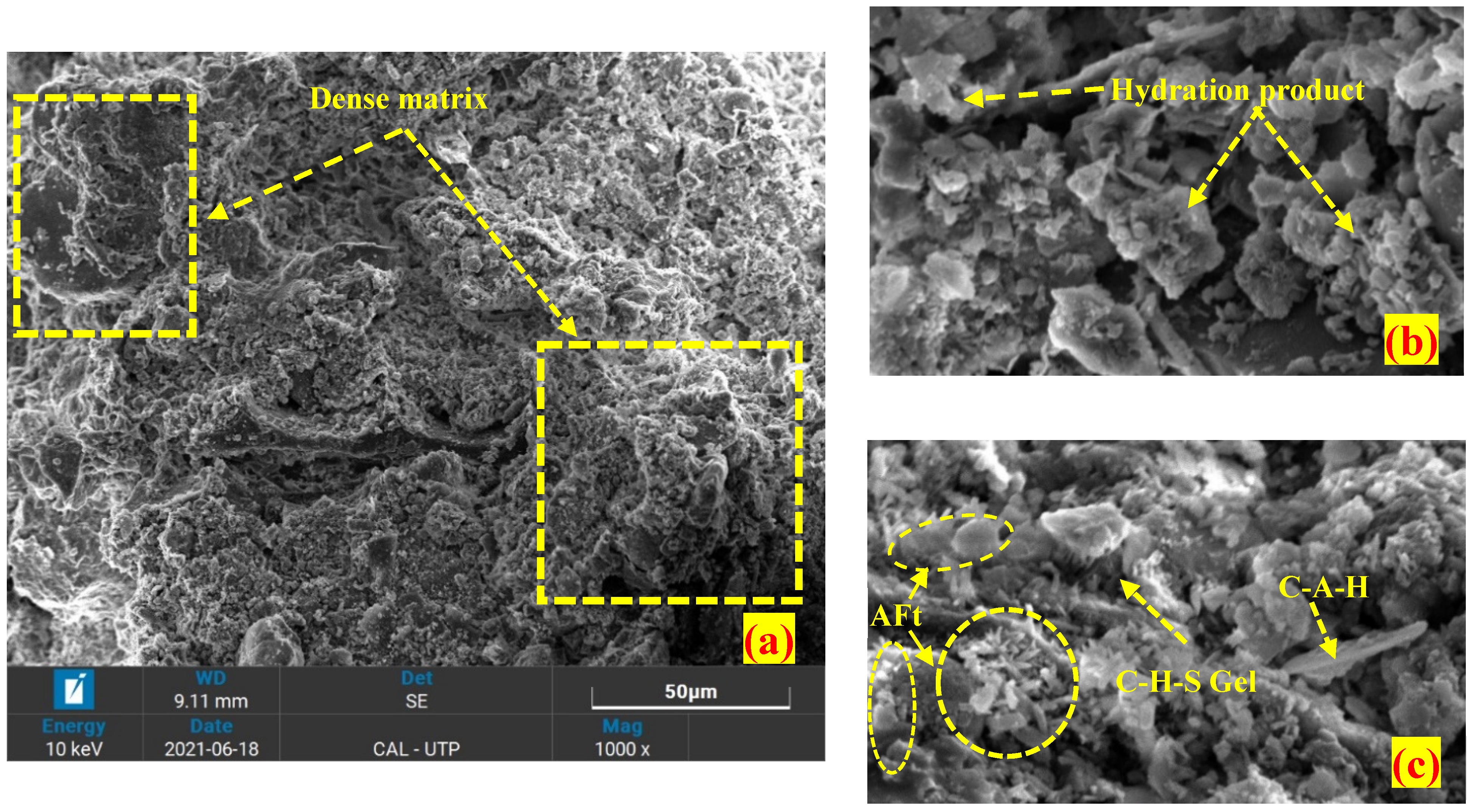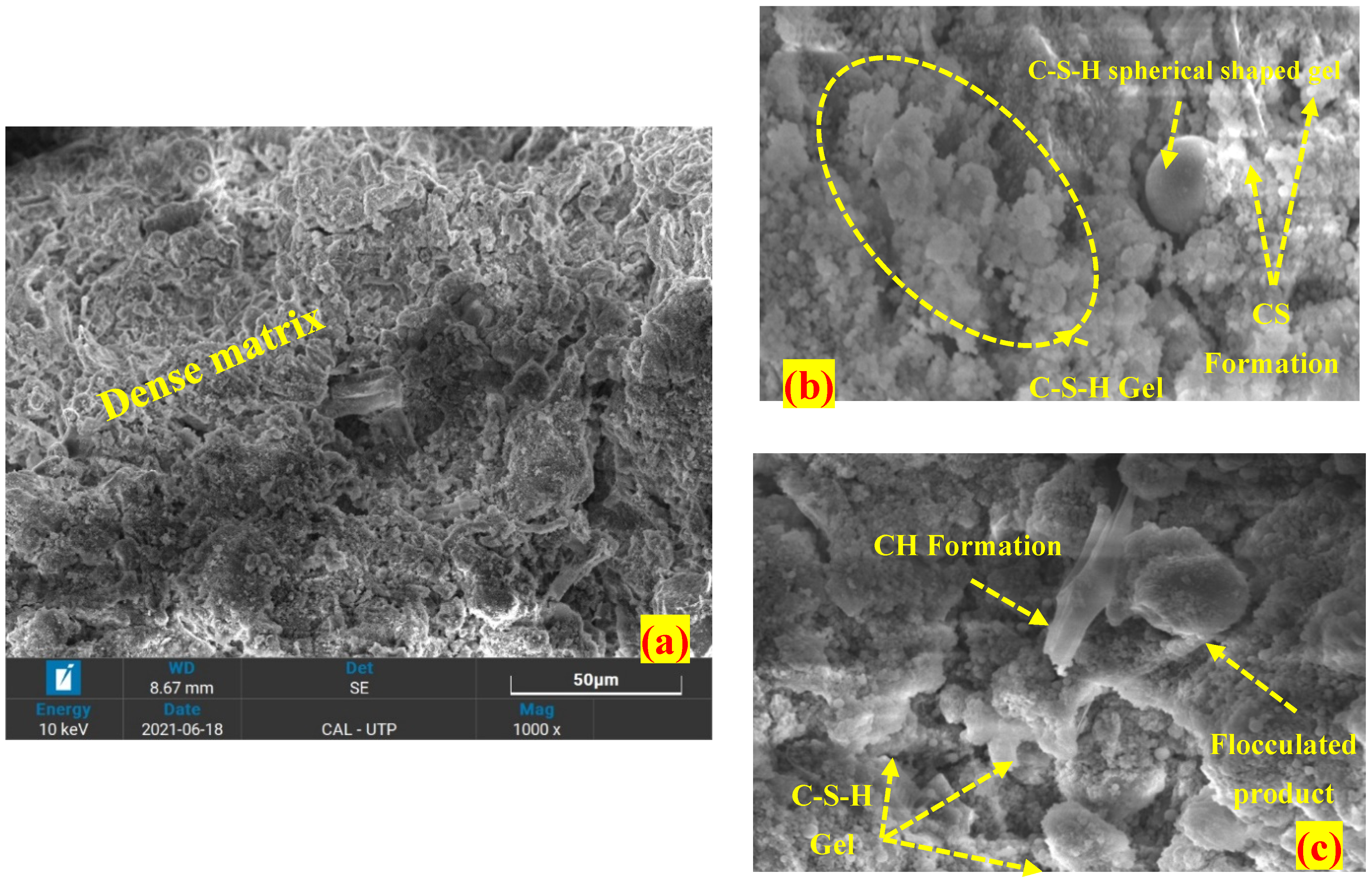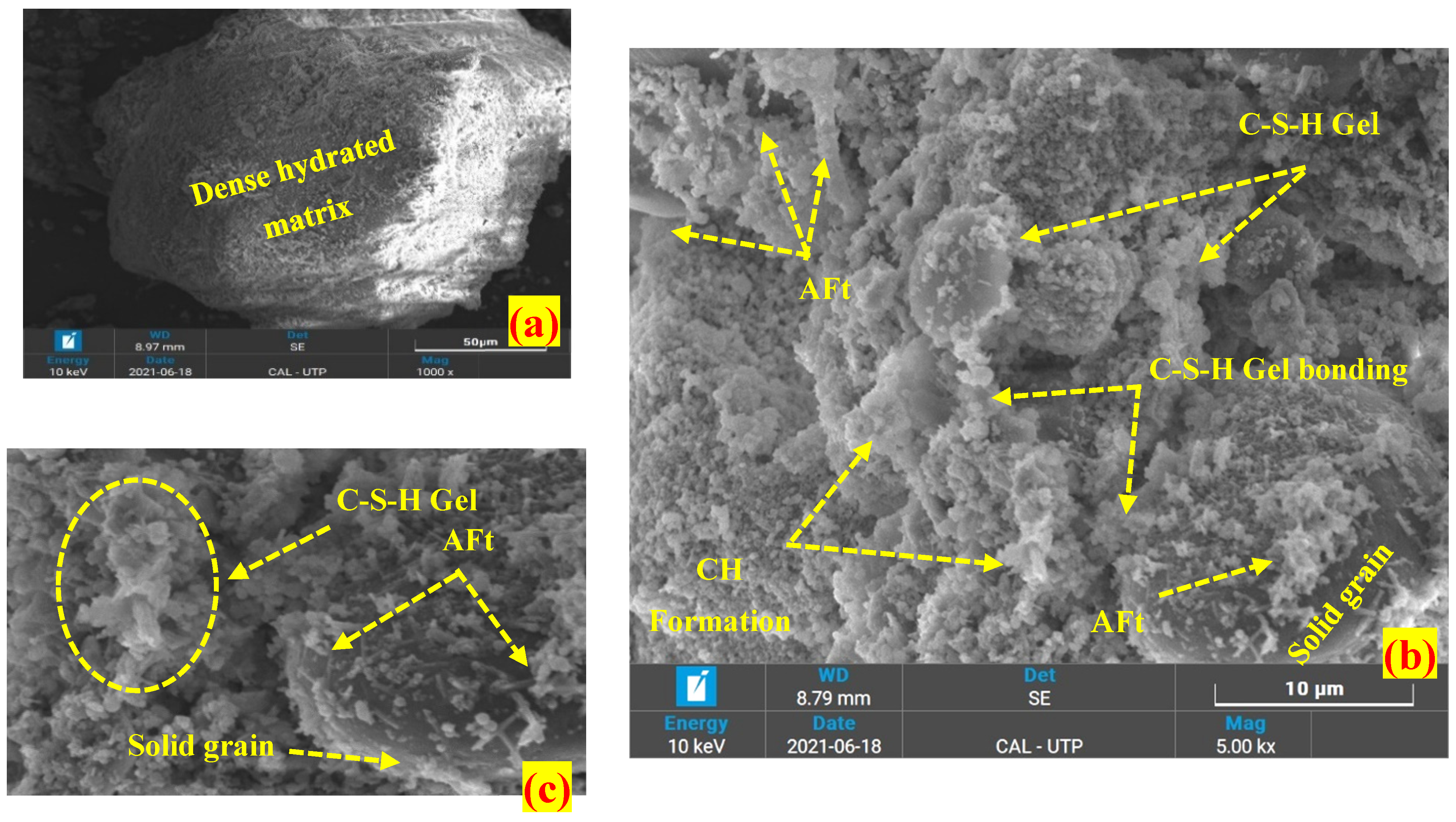Microstructural Characterization of Fibric Peat Stabilized with Portland Cement and Silica Fume
Abstract
:1. Introduction
2. Materials and Experimental Procedure
2.1. Peat Details
2.2. Peat Elemental Analysis (EDX Mapping)
2.3. Properties of Binders
2.4. Experimental Testing Matrix
2.4.1. Scanning Electron Microscopy (SEM)
2.4.2. X-ray Diffraction (XRD)
2.4.3. Fourier-Transform Infrared Spectroscopy (FTIR)
2.4.4. Thermogravimetric Analysis (TGA)
3. Results and Discussion
3.1. Scanning Electron Microscopy (SEM)
3.2. X-ray Diffraction (XRD)
3.3. Fourier-Transform Infrared Spectroscopy (FTIR)
3.4. Thermogravimetric Analysis (TGA)
4. Conclusions and Recommendations
- The morphological test (SEM) exposed hollow cavities/pores, spongy organic matters, and the flaky and loosely packed internal structure of the parent peat which is responsible for its low compressive and bearing capacity. On the other hand, a compact matrix with strong interparticle bonding is revealed in the SF and OPC stabilized peat.
- The morphological alteration in the stabilized peat is further investigated in XRD and observed in the formation of a newly developed compound. The hydration products, i.e., calcium hydrate (CH) and calcium silicate hydrate (C-S-H) are dominantly found in the SF-treated peat. Similarly, the Aft formation, calcium hydrate (CH), calcium silicate hydrate (C-S-H), and calcium aluminate hydrates (CAH) are the prominent products found in the OPC and SF-OPC treated peat.
- The prominent functional groups were observed during FTIR spectral analysis in the stabilized peat including Si-O, –C=O, O-H stretching, and C=C and Ca-OH bond formation.
- The TG analysis revealed that untreated peat decomposes in the first stage (27–150 °C). Most of the hydrated products in the stabilized peat undergo decomposition in the second stage of heating (150–600 °C). Moreover, the ettringite (Aft) developed as a result of OPC incorporation decomposes beyond 600 °C.
- This study revealed the microstructural changes that occurred in Teluk Intan peat using an industrial stabilizer SF and OPC. While the mechanical aspect of the same peat using SF and OPC is evaluated by Ahmad et al. [27]. However, the environmental effect of industrial waste (SF) and OPC in peat is still lacking and needs to be assessed.
Author Contributions
Funding
Institutional Review Board Statement
Informed Consent Statement
Data Availability Statement
Acknowledgments
Conflicts of Interest
References
- Wetlands International. A Quick Scan of Peatlands in Malaysia; Wetlands International: Petaling Jaya, Malaysia, 2010. [Google Scholar]
- Ahmad, A.; Sutanto, M.H.; Al-Bared, M.A.M.; Harahap, I.S.H.; Abad, S.V.A.N.K.; Khan, M.A. Physio-Chemical Properties, Consolidation, and Stabilization of Tropical Peat Soil Using Traditional Soil Additives—A State of the Art Literature Review. KSCE J. Civ. Eng. 2021, 25, 3662–3678. [Google Scholar] [CrossRef]
- Ghadr, S.; Hung, C. Stabilisation of peat with colloidal nanosilica. Mires Peat 2020, 26, 1–13. [Google Scholar] [CrossRef]
- Osman, K.T. Peat Soils. In Management of Soil Problems: An Introduction; Springer: Cham, Switzerland, 2018; pp. 146–183. [Google Scholar] [CrossRef]
- Page, S.E.; Morrison, R.; Hooijer, A.; Rieley, J.O.; Juahiainen, J. Review of Peat Surface Greenhouse Gas Emissions from Oil Palm Plantations in Southeat Asia; ICCT White Paper 15; The International Council on Clean Transportation (ICCT): Washington, DC, USA, 2011. [Google Scholar]
- Paul, A.; Hussain, M. Sustainable Use of GGBS and RHA as a Partial Replacement of Cement in the Stabilization of Indian Peat. Int. J. Geosynth. Ground Eng. 2020, 6, 4. [Google Scholar] [CrossRef]
- Al-Hokabi, A.; Hasan, M.; Amran, M.; Fediuk, R.; Vatin, N.I.; Klyuev, S. Improving the Early Properties of Treated Soft Kaolin Clay with Palm Oil Fuel Ash and Gypsum. Sustainability 2021, 13, 10910. [Google Scholar] [CrossRef]
- Ali, M.; de Azevedo, A.; Marvila, M.; Khan, M.; Memon, A.; Masood, F.; Almahbashi, N.; Shad, M.; Khan, M.; Fediuk, R.; et al. The Influence of COVID-19-Induced Daily Activities on Health Parameters—A Case Study in Malaysia. Sustainability 2021, 13, 7465. [Google Scholar] [CrossRef]
- Ahmad, A.; Sutanto, M.H.; Harahap, I.S.H.; Al-Bared, M.A.M.; Khan, M.A. Feasibility of Demolished Concrete and Scraped Tires in Peat Stabilization—A Review on the Sustainable Approach in Stabilization. In Proceedings of the Second International Sustainability and Resilience Conference: Technology and Innovation in Building Designs, Sakheer, Bahrain, 11–12 November 2020; pp. 1–5. [Google Scholar] [CrossRef]
- Wahab, A.; Embong, Z.; Hasan, M.; Musa, H.; Zaman, Q.U.; Ullah, H. Peat soil engineering and mechanical properties improvement under the effect of EKS technique at Parit Kuari, Batu Pahat, Johor, West Malaysia. Bull. Geol. Soc. Malays. 2020, 70, 133–138. [Google Scholar] [CrossRef]
- Juha, F.; Leena, K.-T.; Pyry, P. Mass Stabilization as a Ground Improvement Method for Soft Peaty. In Peat; InTechOpen: London, UK, 2018; pp. 107–139. [Google Scholar] [CrossRef]
- Khan, A.; Adil, M.; Ahmad, A.; Hussain, R.; Zaman, H. Stabilization of Soil Using Cement and Bale Straw. Int. J. Adv. Eng. Res. Dev. 2018, 5, 44–49. [Google Scholar]
- Vishwanath, G.; Pramod, K.; Ramesh, V. Peat soil stabilization with Rice husk ash and lime powder. Int. J. Innov. Sci. Res. 2014, 9, 225–227. [Google Scholar]
- Zambri, N.M.; Ghazaly, Z.M. Peat Soil Stabilization using Lime and Cement. E3S Web Conf. 2018, 34, 01034. [Google Scholar] [CrossRef]
- Deboucha, S.; Hashim, R.; Alwi, A. Engineering Properties of Stabilized Tropical Peat Soils. Electron. J. Geotech. Eng. 2008, 13, 1–9. [Google Scholar]
- Kolay, P.; Pui, M. Peat Stabilization using Gypsum and Fly Ash. UNIMAS E-J. Civ. Eng. 2010, 1, 1–5. [Google Scholar]
- Kalantari, B.; Prasad, A.; Huat, B.B.K. Cement and Silica Fume Treated Columns to Improve Peat Ground. Arab. J. Sci. Eng. 2013, 38, 805–816. [Google Scholar] [CrossRef]
- Paul, A.; Hussain, M. Cement Stabilization of Indian Peat: An Experimental Investigation. J. Mater. Civ. Eng. 2020, 32, 04020350. [Google Scholar] [CrossRef]
- Abdel-Salam, A.E. Stabilization of peat soil using locally admixture. HBRC J. 2018, 14, 294–299. [Google Scholar] [CrossRef] [Green Version]
- Yusof, Z.M.; Harris, S.N.M.; Mohamed, K. Compressive Strength Improvement of Stabilized Peat Soil by Pond Ash—Hydrated Lime Admixture. Appl. Mech. Mater. 2015, 747, 242–245. [Google Scholar] [CrossRef]
- Jais, I.B.M.; Abdullah, N.; Ali, M.A.M.; Johar, M.A. Peat modification integrating Geopolymer and fly ash. IOP Conf. Ser. Mater. Sci. Eng. 2019, 527, 012021. [Google Scholar] [CrossRef]
- Khanday, S.A.; Ahongshangbam, D.; Hussain, M. Durability of Peat Stabilized with RHA—Based Geopolymer Formed by Adding Pure Alumina. Int. J. Geosynth. Gr. Eng. 2022, 7, 54. [Google Scholar] [CrossRef]
- Khanday, S.A.; Hussain, M.; Das, A.K. Ground-Granulated Blast Furnace Slag-Based Geopolymer-Treated Fibrous Peat. In Recent Trends in Civil Engineering; Sil, A., Kontoni, D.-P.N., Pancharathi, R.K., Eds.; Springer: Singapore, 2021; pp. 409–418. [Google Scholar]
- Kalantari, B.; Prasad, A.; Huat, B.B.K. Stabilising peat soil with cement and silica fume. Proc. Inst. Civ. Eng. Geotech. Eng. 2011, 164, 33–39. [Google Scholar] [CrossRef]
- Kalantari, B.; Prasad, A. Transportation Geotechnics A study of the effect of various curing techniques on the strength of stabilized peat. Transp. Geotech. 2014, 1, 119–128. [Google Scholar] [CrossRef]
- Rahgozar, M.A.; Saberian, M. Geotechnical properties of peat soil stabilised with shredded waste tyre chips. Mires Peat 2016, 18, 1–12. [Google Scholar] [CrossRef]
- Saberian, M.; Rahgozar, M.A. Geotechnical properties of peat soil stabilised with shredded waste tyre chips in combination with gypsum, lime or cement. Mires Peat 2016, 18, 1–16. [Google Scholar] [CrossRef]
- Ahmad, A.; Sutanto, M.H.; Rosmawati, N.; Bujang, M.; Mohamad, M.E. The Implementation of Industrial Byproduct in Malaysian Peat Improvement: A Sustainable Soil Stabilization Approach. Materials 2021, 14, 7315. [Google Scholar] [CrossRef] [PubMed]
- Paul, A.; Hussain, M. An experiential investigation on the compressibility behavior of cement-treated Indian peat. Bull. Eng. Geol. Environ. 2020, 79, 1471–1485. [Google Scholar] [CrossRef]
- Rikmann, E.; Zekker, I.; Teppand, T.; Pallav, V.; Shanskiy, M.; Mäeorg, U.; Tenno, T.; Burlakovs, J.; Liiv, J. Relationship between Phase Composition and Mechanical Properties of Peat Soils Stabilized Using Oil Shale Ash and Pozzolanic Additive. Water 2021, 13, 942. [Google Scholar] [CrossRef]
- Moayedi, H.; Kazemian, S.; Huat, B.B.K. Shear Strength Parameters of Improved Peat by Chemical Stabilizer. Geotech. Geol. Eng. 2013, 31, 1089–1106. [Google Scholar] [CrossRef]
- Kolay, P.K.; Rahman, A. Physico-geotechnical properties of peat and its stabilisation. Proc. Inst. Civ. Eng. Ground Improv. 2016, 169, 206–216. [Google Scholar] [CrossRef]
- Wong, L.S.; Hashim, R.; Ali, F. Improved strength and reduced permeability of stabilized peat: Focus on application of kaolin as a pozzolanic additive. Constr. Build. Mater. 2013, 40, 783–792. [Google Scholar] [CrossRef] [Green Version]
- Kolay, P.K.; Taib, N.S.L. Physical and Geotechnical Properties of Tropical Peat and Its Stabilization. In Bülent Topcuoğlu and Metin Turan; IntechOpen: London, UK, 2018; p. 13. [Google Scholar] [CrossRef] [Green Version]
- Rahman, Z.A.; Sulaiman, N.; Rahim, S.A.; Idris, W.M.R.; Lihan, T. Effect of cement additive and curing period on some engineering properties of treated peat soil. Sains Malays. 2016, 45, 1679–1687. [Google Scholar]
- Tang, B.L.; Bakar, I.; Chan, C.M. Reutilization of organic and peat soils by deep cement mixing. Int. J. Civ. Environ. Eng. 2011, 5, 87–92. [Google Scholar] [CrossRef]
- Islam, M.S.; Hashim, R. Behaviour of stabilised peat: A field study. Sci. Res. Essays 2010, 5, 2366–2374. [Google Scholar]
- Sapar, N.I.F.; Matlan, S.J.; Mohamad, H.M.; Alias, R. A Study on Physical and Morphological Characteristics of Tropical Peat in Sabah. Int. J. Adv. Res. Eng. Technol. 2020, 11, 542–553. [Google Scholar] [CrossRef]
- Amuda, A.G.; Hasan, A.; Unoi, D.N.D.; Linda, S.N. Strength and compressibility characteristics of amorphous tropical peat. J. Geoengin. 2019, 14, 85–96. [Google Scholar] [CrossRef]
- Islam, M.S.; Hashim, R. Bearing capacity of stabilised tropical peat by deep mixing method. Aust. J. Basic Appl. Sci. 2009, 3, 682–688. [Google Scholar]
- Sargent, P. The Development of Alkali-Activated Mixtures for Soil Stabilization. In Handbook of Alkali-Activated Cements, Mortars and Concretes; Woodhead Publishing Limited; Woodhead Publishing: Sawston, UK, 2015; pp. 555–604. [Google Scholar] [CrossRef]
- Lemos, S.G.F.P.; Almeida, M.D.S.S.; Consoli, N.C.; Nascimento, T.Z.; Polido, U.F. Field and Laboratory Investigation of Highly Organic Clay Stabilized with Portland Cement. J. Mater. Civ. Eng. 2020, 32, 1–10. [Google Scholar] [CrossRef]
- Khanday, S.A.; Hussain, M.; Das, A.K. Rice Husk Ash–Based Geopolymer Stabilization of Indian Peat: Experimental Investigation. J. Mater. Civ. Eng. 2021, 33, 04021347. [Google Scholar] [CrossRef]
- Khanday, S.A.; Hussain, M.; Das, A.K. Stabilization of Indian peat using alkali-activated ground granulated blast furnace slag. Bull. Eng. Geol. Environ. 2021, 80, 5539–5551. [Google Scholar] [CrossRef]
- Moayedi, H.; Kassim, K.A.; Kazemian, S.; Raftari, M.; Mokhberi, M. Improvement of Peat Using Portland Cement and Electrokinetic Injection Technique. Arab. J. Sci. Eng. 2014, 39, 6851–6862. [Google Scholar] [CrossRef]
- Bahmani, S.H.; Huat, B.B.; Asadi, A.; Farzadnia, N. Stabilization of residual soil using SiO2 nanoparticles and cement. Constr. Build. Mater. 2014, 64, 350–359. [Google Scholar] [CrossRef]
- Aiken, G.R. Humic Substances in Soil, Sediment, and Water. Geochemistry, Isolation, and Characterization; Wiley: New York, NY, USA, 1985. [Google Scholar] [CrossRef]
- Al-Bared, M.A.M.; Harahap, I.S.H.; Marto, A.; Abad, S.V.A.N.K.; Mustaffa, Z.; Ali, M.O.A. Mechanical behaviour of waste powdered tilesand portland cement treated soft clay. Geomech. Eng. 2019, 19, 37–47. [Google Scholar] [CrossRef]
- Yacob, L.S.; Som, A.M. Stabilisation of peat soil using magnesium oxide: A preliminary study. Malays. J. Anal. Sci. 2020, 24, 578–586. [Google Scholar]
- Latifi, N.; Rashid, A.S.A.; Marto, A.; Tahir, M. Effect of magnesium chloride solution on the physico-chemical characteristics of tropical peat. Environ. Earth Sci. 2016, 75, 220. [Google Scholar] [CrossRef]
- Krumins, J.; Klavins, M.; Seglins, V.; Kaup, E. Comparative study of peat composition by using FT-IR spectroscopy. Mater. Sci. Appl. Chem. 2012, 26, 106–114. [Google Scholar]
- Paul, A.; Hussain, M.; Ramu, B. The physicochemical properties and microstructural characteristics of peat and their correlations: Reappraisal. Int. J. Geotech. Eng. 2021, 15, 692–703. [Google Scholar] [CrossRef]
- Paul, A.; Hussain, M. Geotechnical properties and microstructural characteristics of Northeast Indian peats. Mires Peat 2019, 24, 1–15. [Google Scholar] [CrossRef]
- Sabrin, S.; Siddiqua, S.; Muhammad, N. Understanding the effect of heat treatment on subgrade soil stabilized with bentonite and magnesium alkalinization. Transp. Geotech. 2019, 21, 100287. [Google Scholar] [CrossRef]
- Ghantous, R.M.; Farnam, Y.; Unal, E.; Weiss, J. The influence of carbonation on the formation of calcium oxychloride. Cem. Concr. Compos. 2016, 73, 185–191. [Google Scholar] [CrossRef]
- Francioso, O.; Ciavatta, C.; Montecchio, D.; Tugnoli, V.; Sánchez-Cortés, S.; Gessa, C. Quantitative estimation of peat, brown coal and lignite humic acids using chemical parameters, 1H-NMR and DTA analyses. Bioresour. Technol. 2003, 88, 189–195. [Google Scholar] [CrossRef]








| Element | Atomic (%) | Weight (%) |
|---|---|---|
| Aluminum | 4.59 | 7.83 |
| Calcium | 0.31 | 0.80 |
| Carbon | 41.97 | 31.88 |
| Oxygen | 45.62 | 46.17 |
| Silicon | 7.50 | 13.32 |
| Properties | Value/Description |
|---|---|
| Appearance | Ultrafine amorphous powder |
| Colour | Grey, off-white |
| Odor | Odorless |
| pH @ 20 °C | 6.0–9.0 |
| Solubility (water) | Insoluble/slightly soluble |
| Solubility (Organic solvents) | Insoluble/slightly soluble |
| Melting point | 1550–1700 °C |
| Bulk density | 150–700 kg/m3 |
| Specific gravity | 2100–2300 kg/m3 |
| Particle Size | 0.4–0.5 μm |
| Oxides (% Weight) | Peat | SF | OPC |
|---|---|---|---|
| CO2 | 90.12 | - | - |
| Al2O3 | 0.746 | 0.876 | 2.68 |
| SiO2 | 6.64 | 91.0 | 12.3 |
| CaO | 0.355 | 1.20 | 75.5 |
| FexOy | 0.673 | 3.39 | 2.86 |
| K2O | 0.045 | 1.42 | 0.479 |
| TiO2 | 0.020 | 0.013 | 0.231 |
| SO3 | 0.942 | 0.352 | 1.32 |
| MgO | 0.142 | 0.409 | 1.80 |
| P2O5 | 0.030 | - | - |
| ZrO2 | - | 0.075 | 0.217 |
| MoO3 | 0.24 | 0.052 | 1.29 |
| MnO | - | 0.205 | 0.411 |
| ZnO | 0.032 | 0.0292 | 0.0275 |
| Total weight (%) | 99.98 | 99.02 | 99.10 |
| Combination | SEM | XRD | FTIR | TGA |
|---|---|---|---|---|
| Peat | ✓ | ✓ | ✓ | ✓ |
| Peat + OPC | ✓ | ✓ | ✓ | ✓ |
| Peat + SF | ✓ | ✓ | ✓ | ✓ |
| Peat + OPC + SF | ✓ | ✓ | ✓ | ✓ |
| Wavelength (cm−1) | Tentatively Assigned Band |
|---|---|
| 3450 | O-H stretching |
| 2341 | –C=O stretching of the aliphatic compound |
| 1650 | C=C of cyclic compounds |
| 1400 | Ca-OH bond formation |
| 1040 | Polysaccharide occurrence |
| 803 | C=C bond formation |
| 790 | Si-O stretching |
Disclaimer/Publisher’s Note: The statements, opinions and data contained in all publications are solely those of the individual author(s) and contributor(s) and not of MDPI and/or the editor(s). MDPI and/or the editor(s) disclaim responsibility for any injury to people or property resulting from any ideas, methods, instructions or products referred to in the content. |
© 2022 by the authors. Licensee MDPI, Basel, Switzerland. This article is an open access article distributed under the terms and conditions of the Creative Commons Attribution (CC BY) license (https://creativecommons.org/licenses/by/4.0/).
Share and Cite
Ahmad, A.; Sutanto, M.H.; Ahmad, N.R.; Mohamad, M.E.; Bujang, M. Microstructural Characterization of Fibric Peat Stabilized with Portland Cement and Silica Fume. Materials 2023, 16, 18. https://doi.org/10.3390/ma16010018
Ahmad A, Sutanto MH, Ahmad NR, Mohamad ME, Bujang M. Microstructural Characterization of Fibric Peat Stabilized with Portland Cement and Silica Fume. Materials. 2023; 16(1):18. https://doi.org/10.3390/ma16010018
Chicago/Turabian StyleAhmad, Afnan, Muslich Hartadi Sutanto, Niraku Rosmawati Ahmad, Mazizah Ezdiani Mohamad, and Mastura Bujang. 2023. "Microstructural Characterization of Fibric Peat Stabilized with Portland Cement and Silica Fume" Materials 16, no. 1: 18. https://doi.org/10.3390/ma16010018






